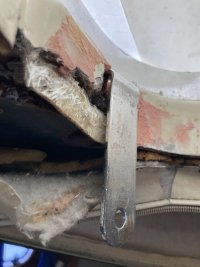Zippy
Junior Member
Greetings - I have a 1989 E 32-200 and over the years the mast hold down has been slowly cracking the inner coming where the mast passes through, is this normal? I'm wondering if this is due to flexing of the cabin top or the yard guys cranking too hard on the turnbuckle where it attaches.
My repair plan was to mix up some West System epoxy with CSM and silica, trowel the mix into the void with the stainless hold down in place so it molds a nice groove for future placement. The final step is to drill a hole through the cured epoxy mix for the bolt that keeps it in place.
Has anyone else done this type of repair? You can see that someone before used Bondo but obviously that didn't work very well......
Thanks!

My repair plan was to mix up some West System epoxy with CSM and silica, trowel the mix into the void with the stainless hold down in place so it molds a nice groove for future placement. The final step is to drill a hole through the cured epoxy mix for the bolt that keeps it in place.
Has anyone else done this type of repair? You can see that someone before used Bondo but obviously that didn't work very well......
Thanks!

